Abstract
Over recent decades, a strong subsurface cooling trend in the South Indian Ocean (SIO) occurred, despite a continuous sea surface warming. Previous studies suggest this long-term (around 1960–2000) cooling trend is mainly driven by remote Pacific atmospheric forcing or local Indian Ocean (IO) forcing. This study reveals that the dominant driver of the SIO subsurface cooling trend in different periods is closely related to the phase of Pacific Decadal Oscillation (PDO). Our results suggest that the local IO wind forcing is responsible for the majority of the subsurface cooling trend and overwhelms a weak warming trend induced by the remote tropical Pacific wind forcing during the negative-phase period of PDO during 1960–76. However, this situation reverses during the PDO positive-phase period during 1977–98. Our analysis suggests that the PDO strengthens/weakens the tropical Pacific trade winds during negative/positive phase periods. Furthermore, the multi-decadal variations in the western Pacific induced by PDO impact the SIO subsurface temperature via baroclinic Rossby waves.
1. Introduction
The global mean sea surface temperature (SST) has been warming over the past century mainly due to anthropogenic forcing (IPCC, Citation2013). This warming leads to a weakening of the Pacific Walker Circulation (Vecchi et al., Citation2006) which is also influenced by natural variability (Power and Kociuba, Citation2011), and a combined invigoration of the Indian Ocean (IO) Hadley and Walker cells, which further results in the changes of Ekman pumping velocity (EPV) and sea levels in the IO (Han et al., Citation2006, Citation2010, Citation2014).
The SST in the equatorial IO has increased by 0.5–1 °C during 1960–99 (Alory and Meyers, Citation2009). However, the sea surface warming is accompanied by a strong cooling in the upper thermocline in the South Indian Ocean (SIO) around 10°S during 1960–99 (Han et al., Citation2006). The cause of this cooling has been debated (e.g. Han et al., Citation2006; Alory et al., Citation2007; Trenary and Han, Citation2008; Schwarzkopf and Böning, Citation2011). Some studies suggested that the thermocline cooling in the tropical SIO was primarily caused by the local IO atmospheric forcing (e.g. Han et al., Citation2006; Treary and Han Citation2008), since the local anomalous winds produced an upward EPV, which in turn shoaled the thermocline, resulting in an upper-thermocline cooling and increased vertical stratification. This change in the IO winds is perhaps linked to anthropogenic forcing (e.g. Cai et al., Citation2007; Cowan et al., Citation2013; Cowan and Cai Citation2013). Based on the IPCC-class models’ results, anthropogenic aerosols were found to play an important role in the tropical SIO subsurface cooling, since increasing aerosols results in the equatorial heat loss through the processes of strengthening the global Conveyor; an intensification of the Agulhas outflow and its retroflection; and subtropical gyre poleward shift and spin-up. However, other studies emphasized that the cooling trend of the tropical SIO thermocline over recent decades was mainly associated with the observed weakening of the remote Pacific trade winds (e.g. Alory et al., Citation2007; Schwarzkopf and Böning, Citation2011). These long-term changes (1960–99) in the SIO subsurface (7–15°S, 100–300 m) involved a strong contribution from the western Pacific via baroclinic Rossby wave transmission of the thermocline anomalies through the Indonesian Archipelago, whereas the interannual variability in the south-west tropical IO was mainly governed by the local IO atmospheric forcing.
To date, most studies have analysed the climate changes in the IO over the long period such as during 1960–2000. However, Trenary and Han (Citation2013) investigated the role of the local and remote forcing in the IO climate decadal changes over different periods. They suggested that decadal variations in the sea level and thermocline depth could be determined in terms of a local baroclinic Sverdrup balance forced by EPV prior to the early 1990s, whereas after the early 1990s, the remote equatorial Pacific trade winds forced thermocline variations that modified the sea level and thermocline depth across the tropical SIO basin.
Previous studies have not investigated to link the multi-decadal changes in the SIO subsurface temperature to the phase changes of Pacific Decadal Oscillation (PDO) (Mantua et al., Citation1997). The PDO is the result of a combination of different physical process (Newman et al., Citation2016); is the dominant decadal climate signal occurring in the North Pacific; and has a large impact on global climate (England et al., Citation2014). In this study, we explore how the relative contributions of the remote Pacific and local IO forcing to affect multi-decadal changes of the SIO subsurface temperature during different PDO phases via a suite of ocean model experiments. Section 2 introduces the ocean model and experimental design. The results will be presented in Section 3, and finally summary and discussion are given in Section 4.
2. Model description and experimental design
2.1. Model description
The ocean component of the Australian Community Climate and Earth System Simulator (ACCESS-OM; Bi et al., Citation2013) is used here for model experiments. The ACCESS-OM comprises the NOAA/GFDL Modular Ocean Model version 4p1 (Griffies, Citation2009); the LANL4 Sea-ice Model version 4.0(CICE4.0; Hunke and Lipscomb, Citation2010); and the CERFACS5 OASIS3.25 coupler (Valcke, Citation2006). The horizontal resolution of the ocean model is a uniform 1° in the longitudinal direction. In the meridional direction, the grid spacing is nominally 1° resolution with three refinements: (a) 1/3° between 10°S and 10°N; (b) tripolar Arctic north of 65°N; and (c) a Mercator (cosine-dependent) implementation for the southern hemisphere ranging from 0.25° at 78°S to 1° at 30°S. The vertical discretization has 50 levels covering 0–6000 m. In the top 200 m, the resolution is uniform with a grid spacing of 10 m. Below 200 m, vertical grid spacing increases linearly to 330 m at the bottom-most tracer cell. We use Coordinated Ocean-ice Reference Experiments (CORE-II) forcing data-set (Large and Yeager, Citation2009). The CORE-II data-set provides the air temperature, winds, air-specific humidity, rainfall rate and snowfall rate, pressure at 10 m, downward shortwave radiation, downward longwave radiation and river run-off.
2.2. Experimental design
Two parallel experiments are conducted here. One is with the Indonesian passages open which allows an Indonesian Throughflow (ITF) (referred to as CTRL), but the other has the Indonesian passages artificially closed thus blocking the ITF (called IND) which is same as that in Zhou et al. (Citation2015). The ITF experiment provides the ocean connection for the IO and Pacific basin interactions via carrying warm and freshwater from the western Pacific to the IO while allowing Rossby waves to propagate westward. Previous studies did similar experiments with or without the ITF to explore the impacts on the climatological mean states and interannual variability in the IO and Pacific (e.g. Hirst and Godfrey, Citation1993; Lee et al., Citation2002; Yu et al., Citation2004; Song et al., Citation2007; Kajtar et al., Citation2015). However, here we do these model experiments to explore how the multi-decadal changes of the SIO subsurface temperature are impacted by the remote Pacific forcing.
In IND, the climate variability in the IO is driven by local IO atmospheric forcing only, whereas the differences of model results with and without ITF in the IO region are mainly attributed to remote Pacific forcing (referred to as DIF hereafter). Note that a linear assumption is used here. It indicates that the superposition of solutions with and without ITF equals the total solution. Schwarzkopf and Böning (Citation2011) proposed that the total trend in the temperature or sea level is just the sum of the trends produced by the local IO and remote Pacific forcing. They set up three model experiments. The first one was globally forced with CORE-II interannual forcing like our CTRL experiment. The second one was subject to climatological forcing in the world oceans, except for the IO north of 25°S, where the same interannual forcing was used as in the first experiment. In the third one, interannual forcing was applied only to the Pacific north of 50°S. Their last experiment was used to investigate how the remote Pacific forcing impacted the sea level and subsurface temperature in the SIO area. However, Trenary and Han (Citation2012, Citation2013) only configured two experiments following the first two experiments in Schwarzkopf and Böning (Citation2011), since they saw the differences in their two experiments reflecting the effect of the remote Pacific forcing on the local IO and suggested that the linear assumption generally holds in the IO region. The DIF results here, which are the differences between the CTRL’s and IND’s results in the IO, adopt the similar idea as Trenary and Han (Citation2012, Citation2013). Note that DIF should account for both ITF transports and ocean waves transmitted from the western Pacific because of an open ITF in CTRL.
Both IND and CTRL experiments have been spun up for 100 years individually forced with the CORE climatological forcing. After that, they are driven with inter-annually varying CORE-II atmospheric forcing during the period 1948–2007 inclusive under the CORE protocols of Danabasoglu et al. (Citation2014, Citation2016). The ocean analysis used in this study starts from 1960, since the model needs some time to adjust its long-term climatological state to its real-time state. The results of CTRL, IND and DIF are presented below.
3. Results
3.1. Multi-decadal variability of the SIO subsurface temperature
The PDO index, which is also termed the Interdecadal Pacific Oscillation (IPO) in recognition of its extension to the South Pacific (Power et al., Citation1999), is defined as a normalized principle component of the leading empirical orthogonal function of SSTA (after removing the long-term trend) over the North Pacific (20°N–65°N) following Mantua et al. (Citation1997). The IPO and PDO indices are very similar (Folland et al., Citation2002), hence the PDO index is only used for analysis in this study. The PDO is defined in terms of SST anomaly pattern in the North Pacific but has an impact on the global climate (Deser et al., Citation2010).
The time-evolving yearly PDO indices from the CTRL experiment (bar) and observed (green curve) from 1960 to 2007 are shown in Fig. . They are quite similar and their correlation over the period 1960–2007 is even up to 0.98. This is not surprising, since the ocean model is forced with the CORE-II data in which the observed data are assimilated into the atmospheric model. The PDO is in a cold phase in the period 1960–76 (referred to as Period I), but has a shift to a warm phase in the period 1977–98 (Period II), and then moves to a cold phase again after 2000 (Period III). The model results in Period III are less than 10 years due to the unavailability of valid CORE-II forcing data after 2007. This period is too short for multi-decadal changes and hence it is not focused on here.
Fig. 1. Time series of PDO index. The red and blue bars stand for the model CTRL experiment and the green curve represents the ERSST reanalysis.
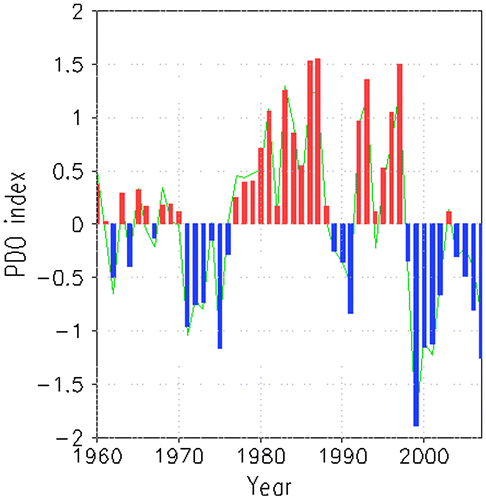
In order to explore the relationship between different PDO phases and the IO multi-decadal changes, the IO variations over the past decades are separated into two distinct periods: Period I (negative PDO phase) and Period II (positive PDO phase). Figure displays the linear trend of zonal mean temperature anomaly in the IO during the period 1960–98, Period I and Period II from a reanalysis of ocean climate using Simple Ocean Data Assimilation (SODA, Carton and Giese, Citation2008). Actually, the trends in different periods look similar. The subsurface around 100–400 m in the region 0–20°S has a cooling trend in both of these periods, despite a warming SST trend.
Fig. 2. Linear trends (°C/century) of zonal-mean temperature in the Indian Ocean during the periods 1960–98, 1960–76 (Period I) and 1977–98 (Period II) from SODA reanalysis.
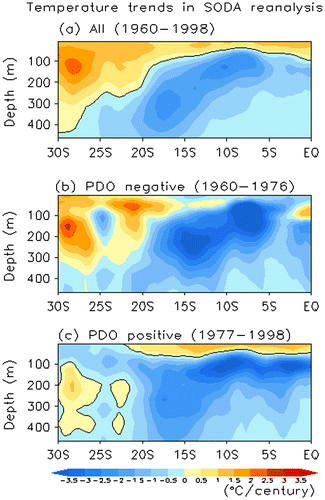
Figure is similar to Fig. but for the model results. The left panels are for the period 1960–98, middle panels for Period I and right panels for Period II. The results in CTRL (Fig. a, d and g) are in agreement with those of SODA reanalysis. This indicates our model results are reliable. The SIO subsurface is cooled over the long 1960–98 period in CTRL (Fig. a) except the south of 25°S, where a warming temperature trend mainly due to a subtropical gyre shift caused by anthropogenic forcing (Cai et al., Citation2007, Citation2010). The cooling trend occurs between 100 and 400 m near the equator to 24°S. In the IND run, the thermocline cooling near 10°S, which is induced by the local IO atmospheric forcing, is still pronounced in spite of a blockage of ITF (Fig. b). However, its cooling area in IND is shrunk and the magnitude of cooling trend becomes weaker compared to CTRL. Figure c shows that the remote Pacific forcing induces cooling trends almost everywhere in the IO. These results are similar to those shown in Schwarzkopf and Böning (Citation2011).
Fig. 3. Left panels: linear trends (°C/century) of zonal-mean temperature in the Indian Ocean during the period 1960–98 in different model experiments for (a) CTRL, (b) IND and (c) DIF. Middle panels and right panels are the same as the left panels but for the periods 1960–76 and 1977–98, respectively. The box in (a) indicates the domain of 9–15°S and 100–300 m depth.
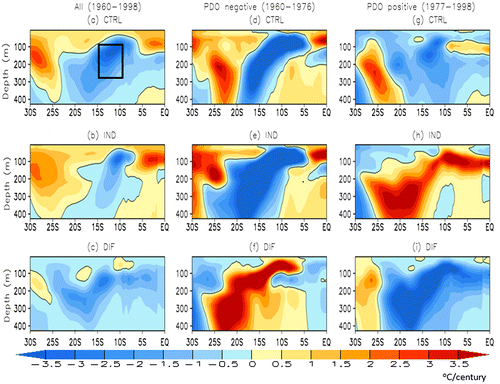
For both Periods I and II, the SIO subsurface temperature in CTRL exhibits a cooling trend around 10°S down to 400 m (Fig. d and g). However, the magnitude of cooling trend in Period I, which extends southward from 5°S to near 20°S, appears stronger than that in Period II. IND similarly shows a cooling trend in Period I (Fig. e) but, in contrast, it changes to warming trend in Period II (Fig. h). Strikingly, the trends in DIF (Fig. f and j) are almost opposite to those in IND during a same period.
Figure displays the time series of the IO zonal mean temperature anomaly index averaged over the domain of 9°S–15°S between 100 and 300 m in the SIO (referred to as SIO index), region exhibiting a strong cooling over the recent decades. The time-evolving SIO index in CTRL (red curve) largely agrees with that in the SODA reanalysis (black curve) in the period 1960–2000. However, the CTRL experiment does not catch the rapid warming in the SIO subsurface after 2000 that occurred in SODA. The result in Fig. c of Schwarzkopf and Böning (Citation2011) seems to have a same problem. We think that this problem is likely related to the deficiency of CORE-II forcing, since both experiments use the same CORE forcing but with a different ocean model. The Pacific trade winds become stronger after 2000. Their strength might be underestimated in the CORE forcing during this period.
Fig. 4. Time series of temperature anomaly (°C) averaged over the domain of 9°–15°S, 30°–130°E between 100 and 300 m (a box in Fig. 3a) for SODA (black), CTRL (red), IND (green) and DIF (blue). The dashed lines denote the linear trends of the corresponding same colour curves for the distinct periods 1960–76 (Period I) and 1977–98 (Period II).
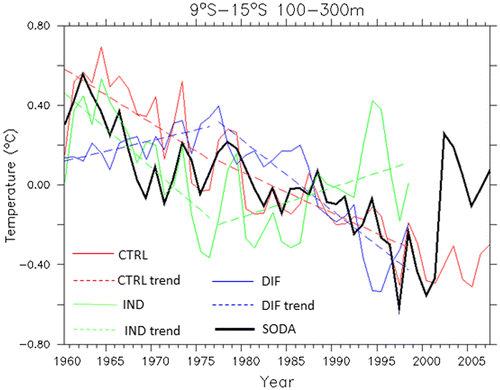
The remote Pacific forcing contributes to 66% of the total temperature trend (−2.31 °C/century) in the SIO index of CTRL, and dominates the decreasing trend overall over the period 1960–98. However, during Period I, the Pacific forcing induces a weak warming trend (1.08 °C/century) and partially offsets the total decreasing trend (−2.83 °C/century) produced by the local IO atmospheric forcing (green line). In Period II, the Pacific forcing results in a strong decreasing trend (−3.50 °C/century), whereas the regional IO forcing contributes an increasing trend (1.64 °C/century). Therefore, the local IO and remote Pacific forcings dominate the total IO temperature cooling trend alternately in these two distinct periods.
3.2. Mechanism of multi-decadal variations of the tropical SIO subsurface
The mechanism of multi-decadal variations of the SIO subsurface will be explored in this section. The PDO, winds and ITF, all affect the multi-decadal changes in the IO. Figure displays the time series of trade wind stress anomalies in the Pacific (averaged over 5°S–5°N and 120°E–70°W) and IO (averaged over 9°S–15°S and 30°E–130°E). The dashed lines indicate the linear trend in Periods I and II. The easterly trade winds in both regions weakened over the long period 1960–2007. There is an abrupt diminishing trend occurring in Period I (4.56 × 10−4 N m−2/year and 5.75 × 10−4 N m−2/year for the Pacific and IO, respectively). In Period II, both trade winds have weak trends. Thus the multi-decadal variations of the Pacific and IO trade are similar. In contrast, on the interannual-time scale, both Pacific and IO trade winds are almost antiphase, since a stronger updraft in the western Pacific warm pool region enhances the Walker Circulation, resulting in strengthening Pacific trade winds but weakening the IO trade winds or vice versa. This antiphase between Pacific and IO trade winds on the interannual time scale leads to some degree of antiphase behaviours in the time series of SIO indices in IND (green curve) and DIF in Fig. (blue curves).
Fig. 5. The tropical Pacific (averaged over 5°S–5°N, 120°E–70°W, blue curve) and the SIO (averaged over 9°S–15°S, 30°E–130°E, green curve) trade wind stress anomalies (10−3 N/m2). The dashed lines indicate the linear trend for the periods 1960–76 and 1977–98.
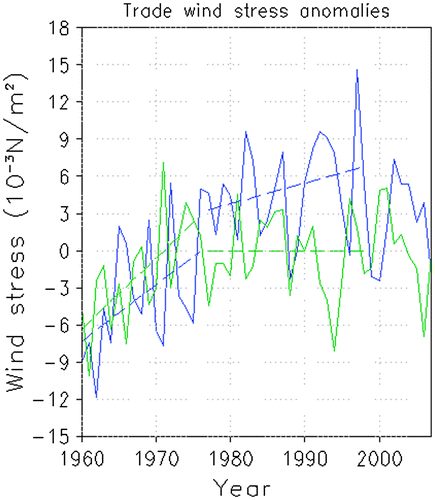
The ITF is the only pathway for interocean exchange between the Pacific and IO basins at tropical latitude. The signals of seasonal or multi-decadal in the Pacific could transmit to the IO through the ITF pathway. The ITF transport is defined as the total net southward transports of Lombok Strait and Ombai Strait and net westward transport in Timor Passage. The negative values indicate transport from the Pacific to the IO. Figure displays the time series of annual ITF volume and heat transports in CTRL from 1960 to 2007. The heat transport is defined as below:(1)
Fig. 6. Time series of ITF volume transport (Sv) (a) and ITF heat transport (PW) (b). The dashed line stands for the linear trends for the periods 1960–76 and 1977–98.
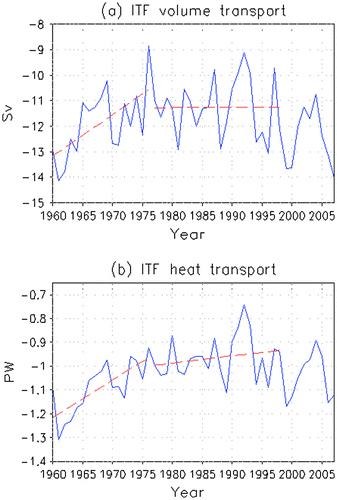
where HT is heat transport which integrates vertically from ocean bottom to sea surface, σ is the corresponding area element, sfc is sea surface height, cp is specific heat of sea water, ρ is density, v is zonal or meridional velocity and T is potential temperature
The ITF volume and heat transports are highly correlated up to 0.75 over the period 1960–2007. Their trends (dashed lines) appear to be consistent in Period I (0.128 Sv/year and 0.157 PW/year for ITF volume and heat transports, respectively). Compared to Period I, there is a weak decreasing trend in the ITF heat transport, and almost no trend in the ITF volume transport in Period II. This result is consistent with that of Lee et al. (Citation2010). They estimated the total ITF volume transport by 14 ocean data assimilation products and found that most products did not show a weakening ITF after mid-1970s. The ITF trends are closely related to decadal changes of the Pacific trade winds, e.g. the rapid weakening in the Pacific trade winds results in a similar reduction in ITF transports over Period I.
The ITF heat transport from the Pacific to the IO rapidly declines in Period I and then reduces relatively slow in Period II. If the multi-decadal change of ITF transports is vital to the SIO subsurface, the SIO index in DIF should quickly drop in Period I and slowly decrease in Period II. However, the SIO index in DIF exhibits a weak warming trend in Period I (recall Fig. ), whereas a strong cooling trend in Period II. This suggests that the role of the ITF transports is not crucial in affecting the SIO subsurface temperature on the multi-decadal time scale, although Lee et al. (Citation2015) found that the IO heat contents in the upper 700 m had abruptly increased and they were originated from the Pacific via the ITF pathway during 2003–12.
The ITF is mainly driven by a sea level gradient from the Pacific to the IO. The sea level gradient is, in turn, maintained by wind patterns in the two basins. Therefore, many factors can affect the ITF transports: e.g. they are significantly impacted by the Indo-Pacific climate variability such as Indian Ocean dipole (IOD) and El Niño–Southern Oscillation (ENSO) (e.g. Yuan et al., Citation2011; Sprintall and Revelard, Citation2014). Ocean waves such as equatorial/coastal Kelvin and Rossby waves drive interannual variation of the ITF with an amplitude of roughly ±3 Sv (Schiller et al., Citation2010). The variations of South China Sea Throughflow (SCST) can also affect the ITF transport, since SCST returns the Pacific via the Makassar Strait and then partly block the Makassar Strait Throughflow which accounts for 80% of total ITF volume transport (Qu et al., Citation2005). In the meantime, the variations of SIO subsurface temperature are affected by the other different factors. Hence, the variations of ITF can impact SIO subsurface temperature in some way, but are not the major factor on the interannual or multi-decadal time scales.
Next we will check the time-evolving vertical mean subsurface temperature between 100 and 300 m in the SIO region (averaged over 9°S–14°S) and the equatorial Pacific (averaged over 5°S–5°N) in CTRL and IND (Fig. ). In CTRL, both SIO (Fig. a) and equatorial Pacific (Fig. b) mainly exhibit positive anomalies in Period I and negative anomalies in Period II. Particularly, the warming or cooling temperature anomaly in the eastern portion of the SIO subsurface is consistent with that in the western Pacific. This suggests that the variations of thermocline depth such as shoaling (cooling thermocline) or deepening (warming thermocline) in the western Pacific are transmitted to the IO via the westward propagation of baroclinic Rossby waves. Several previous studies (e.g. Wijffels and Meyers, Citation2004; Cai et al., Citation2005; Schwarzkopf and Böning, Citation2011) suggested that the westward Pacific Rossby waves excited by zonal winds reach the Pacific west boundaries and reflect Kelvin waves. The reflected Kelvin waves then propagate down the Western Australian coast as coastally trapped waves, radiating Rossby waves into the SIO. In contrast, in the no-ITF IND experiment, the time-evolving temperature anomalies in the eastern tropical SIO are inconsistent with those in the western equatorial Pacific, in spite of a very similar temperature pattern in the equatorial Pacific for both IND and CTRL. Therefore, the remote Pacific forcings affect the SIO subsurface mainly through the Rossby waves rather than the ITF transports.
Fig. 7. Time-evolving annual mean temperature anomalies averaged between 9–15°S and 100–300 m in the IO: (a) for CTRL and (c) for IND and averaged between 10°S–10°N in the Pacific at the same depth from 1960 to 2007: (b) for CTRL and (d) for IND.
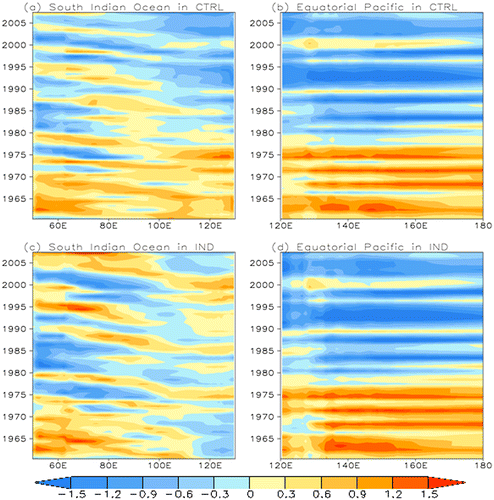
The role of regional IO atmospheric forcing will be investigated here, since it makes the SIO index in IND a sharp cooling in Period I but a warming trend in Period II (recall Fig. ). The EPV is defined below:
(2)
where τx, τy are the zonal and meridional wind stress, is the reference density of the sea water,
is Coriolis parameter. ω = 0.729 × 10−4/s is the angular speed of Earth’s rotation and
the latitude. The long-term annual mean EPV and the EPV linear trends in the IO in Periods I and II are shown in Fig. . Note that the white band along the equator where the calculation is not attempted due to
there. A upwelling region mainly occurs between 5°S and15°S, but a downwelling occurs in the most regions from 15°S to 30°S (Fig. a). The enhanced upwelling is dominated in the region of 5°S–15°S in Period I (Fig. b). It results in a shoaling thermocline and then a cooling in the SIO subsurface in this period. However, the upwelling reduces in the central SIO region between 60 and 80°E in Period II, whereas it becomes stronger in the eastern portion of the SIO (Fig. c). The net effect on the SIO index in IND leads to a warming trend in Period II.
Fig. 8. (a) The climatological annual mean Ekman pumping velocity (EPV) from interannual CORE-II forcing (1 × 10−6 m/s, upwelling is red and downwelling is blue). (b) and (c) are the EPV linear trends (1 × 10−7 m/s year−1) for the periods 1960–76 and 1977–98, respectively.
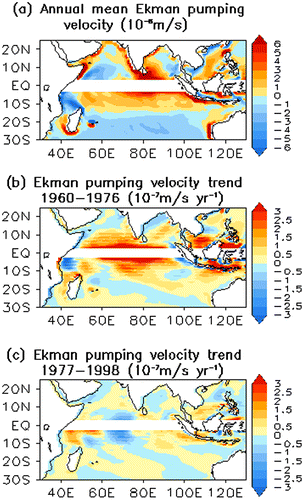
The variations of wind stress can affect the upwelling in the upper oceans and the depth of thermocline and then alter the subsurface temperature. Here we will investigate how the PDO impacts the wind stress in the Indo-Pacific. Figure a displays the annual mean wind stress and regression between the PDO index and zonal wind stress anomaly during the period 1960–98. Figure b shows the regressions onto PDO index of the temperature anomaly (meridionally averaged over 5°S–5°N) along the equator, as a function of depth at the same period. The climatological trade winds blow east to west across the surface of the tropical Pacific and SIO regions. The results show that the positive PDO reduces the intensity of the Pacific trade winds and the IO trade winds in the central and west parts between 5 and 20°S. However, it strengthens the IO trade winds in the eastern part of the tropical IO. Figure b displays that the warm PDO phase leads to El Niño-like warmer temperatures in the central and eastern Pacific and cooler temperatures in the western Pacific.
Fig. 9. (a) Regression between PDO index and zonal wind stress anomaly (10−3 N/m2 sd−1) during the period 1960–98 (colour shading) and climatological annual mean wind stress (N/m2) (arrows). (b) Regression between PDO index and ocean temperature anomaly averaged over 10°S–10°N along the equator (°C sd−1).
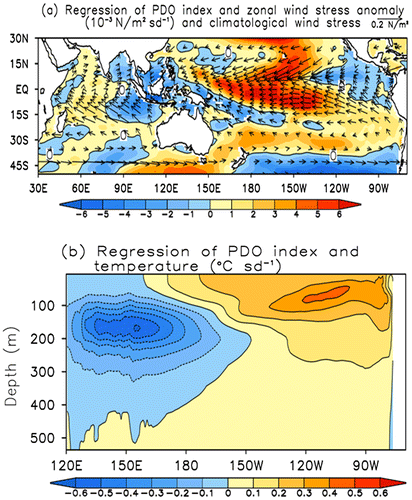
Figure illustrates the trends of temperature averaged over 5°S–5°N along the equatorial Pacific during the periods 1960–98, Periods I and II. The ocean temperatures in the subsurface are persistently cooling due to the long-term weakening of the Pacific trade winds. However, the subsurface temperatures of the western and eastern equatorial Pacific exhibit warming trends in Period I, although the cooling trend still remains in the central Pacific. The warming trend in the western Pacific is very likely to be related to the PDO, since the negative PDO during this period induces stronger Pacific trade winds (recall Fig. a). The stronger trade winds pile up sea water in the western Pacific, and deepen the thermocline, which results in warmer ocean temperatures in this region (recall Fig. b). Note that although the negative PDO strengthens the Pacific trade winds, it cannot beat their long-term weakening induced by anthropogenic global warming, since they still have a weakening trend in Period I (recall Fig. ). This is perhaps the main reason why a cooling still exists in the central Pacific subsurface in Period I. The warmer temperature anomalies propagate westward to the IO through Rossby waves (recall Fig. ) and make the equatorial Pacific forcing contribute a warm trend to the SIO subsurface in Period I (recall Fig. ). In the meantime, the negative PDO weakens the easterly IO trade winds in the eastern SIO portion (recall Fig. a), shoals the thermocline depth there and leads to a cooling trend in the SIO subsurface. The cooling tendency caused by the local IO forcing is much stronger than the warming trend induced by the remote Pacific equatorial forcing and results in continuous cooling in the SIO subsurface in Period I.
Fig. 10. The linear trends of temperature anomaly (°C/decade) along the equatorial Pacific during the periods 1960–98 (a), 1960–76 (b) and 1977–98 (c) in CTRL. (d) Time series of temperature anomaly index (averaged over 10°S–10°N, 120°E–160°E between 100 and 300 m) and its linear trends during the periods 1960–76 and 1977–98 in CTRL.
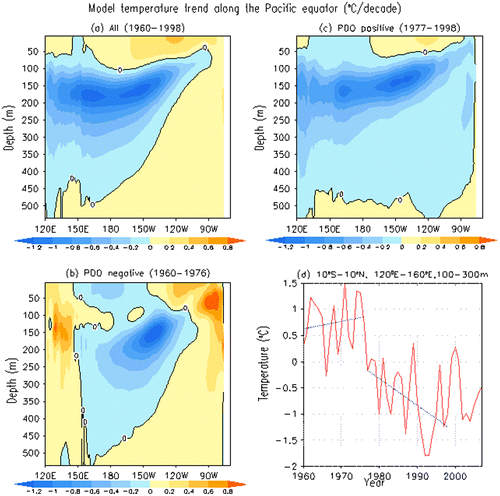
In contrast, after the PDO shifts to the warm (positive) phase in 1976–77, it intensifies the existing long-term weakening tendency of the tropical central Pacific trade winds (recall Fig. a) and leads to a strong cooling trend in the subsurface of equatorial Pacific in Period II. Figure d shows the time series of temperature anomaly index averaged over 10°S–10°N, 120°E–160°E between 100 and 300 m in the western Pacific region. It shows that a weak warming trend at 1.43 °C/century occurs in Period I, whereas a strong cooling trend at −5.1 °C/century in Period II. The strong cooling trend propagates via the westward Rossby waves to the SIO region, beats the warming tendency induced by the local IO forcing and dominates the cooling trend of the SIO subsurface in Period II. The IO trade winds do not exhibit a weakening trend in this period due to being influenced by PDO (recall Fig. b).
4. Summary and discussion
Two parallel experiments based on ACCESS-OM forced with inter-annually varying CORE-II forcing from 1948 to 2007 have been conducted to investigate the multi-decadal variations of the subsurface cooling trend in the SIO over the past decades. In one experiment (CTRL) there is an open ITF, but in another the ITF is blocked. The latter experiment IND therefore simulates the IO in the absence of oceanic connections with the Pacific via the ITF. Note that the interaction between the IO and Pacific basins still exists in IND through the atmosphere processes, since IND uses the same CORE-II atmospheric forcing, which is not modified here and should naturally contain all atmospheric interactions such as the IO Walker Circulation and the Pacific Walker Circulation. Our results suggest that both local IO and remote Pacific atmospheric forcings contribute to the SIO subsurface cooling trend for the overall period 1960–98, although the Pacific forcing contributes the majority of the total trend in CTRL.
Further analysis suggests that if the last few decades are separated into the two distinct periods 1960–76 (Period I) and 1977–98 (Period II), the local IO wind forcing controls the thermocline cooling trend in the SIO in Period I, whereas the remote Pacific wind forcing governs it in Period II. While the local IO/Pacific forcing dominates the cooling trend in Period I/II, the Pacific/IO forcing counteracts it by inducing a weak warming trend in the SIO subsurface. We find that this phenomenon is closely associated with the PDO phase, since the different PDO phase has a different impact on a weakening or strengthening of the Pacific and IO trade winds. During Period I, the cold PDO phase enhances the long-term weakening tendency of trade winds in the eastern SIO region, but strengthens the Pacific trade winds. This leads to intensification of an existing cooling trend in the SIO subsurface as a result of local IO wind forcing, but induces a weak warming trend in the western equatorial Pacific subsurface as a result of Pacific wind forcing. Furthermore, the western tropical Pacific warm signal propagates westward into the SIO region through Rossby waves and then counteracts the cooling trend in the SIO subsurface. Compared to the negative phase, the positive PDO phase in Period II has an opposite effect on both Pacific and IO trades winds. Consequently, IO and Pacific wind forcings dominate the cooling trend in the SIO subsurface in turn.
Note that our results suggest that the multi-decadal changes in ITF heat and volume transports do not play an important role in the SIO thermocline cooling over the recent decades. Both ITF volume and heat transports have a sharp weakening trend in Period I, but the remote Pacific contributes a small warm trend to the SIO subsurface during this period. In contrast, there is no trend or a small weakening trend for ITF volume and heat transport in Period II, but the Pacific induces a strong cooling to the SIO subsurface. The ITF driven by the sea level gradient between the western Pacific and the IO can be significantly affected by the Pacific trade winds, monsoon in the IO, ENSO, IOD, ocean waves, SCST and so on. The impact of variations of ITF on the SIO subsurface temperature is less than ocean waves. Wijffels and Meyers (Citation2004) suggested that about 60%–90% of sea level variability and 70% of thermocline temperature variability in the Indonesian seas and southeast IO could be accounted in terms of free Kelvin and Rossby waves generated by remote zonal winds along the equator of the Indian and Pacific Oceans based on observations.
The PDO shifts to the negative phase after 2000, and leads to a pronounced strengthening in the Pacific trade winds and a hiatus in surface warming (England et al., Citation2014). However, this study does not include the analysis over the recent decade, since our model experiments only run till 2007 due to the limitation of valid CORE-II data-set. The period 2000–07 is too short for the study of decadal variations. We will extend our current study by applying update CORE data when available to force our ocean model as a next step.
Funding
This work was supported by the Australian Government Department of the Environment, the Bureau of Meteorology; CSIRO through the Australian Climate Change Science Program; and the NCI National Facility at the ANU.
Acknowledgements
We thank the reviewers for their helpful comments and assistance in improving the clarity of this article.
References
- Alory, G., Wijffels, S. and Meyers, G. 2007. Observed temperature trends in the Indian Ocean over 1960–1999 and associated mechanisms. Geophys. Res. Lett. 34, L02606. DOI:10.1029/2006GL028044.
- Alory, G. and Meyers, G. 2009. Warming of the upper equatorial Indian Ocean and change in the heat budget (1960–99). J. Clim. 22, 93–113. DOI:10.1175/2008JCLI2330.1.
- Bi, D., Marsland, S. J., Uotila, P., O’Farrell, S., Fiedler, R. and co-authors. 2013. ACCESS-OM: the ocean and sea ice core of the ACCESS coupled model. Aust. Meteorol. Oceanogr. J. 63(1), 213–232.10.22499/2.00000
- Cai, W., Cowan, T., Dix, M., Rotstayn, L., Ribbe, J. and co-authors. 2007. Anthropogenic aerosol forcing and the structure of temperature trends in the southern Indian Ocean. Geophys. Res. Lett. 34, L02606. DOI:10.1029/2007GL030380.
- Cai, W., Cowan, T., Godfrey, S. and Wijffels, S. 2010. Simulations of processes associated with the fast warming rate of the Southern Midlatitude Ocean. J. Clim. 23, 197206.
- Cai, W., Meyers, G. and Shi, G. 2005. Transmission of ENSO signal to the Indian Ocean. Geophys. Res. Lett. 32, L05616. DOI:10.1029/2004GL021736.
- Carton, J. A. and Giese, B. S. 2008. A reanalysis of ocean climate using Simple Ocean Data Assimilation (SODA). Mon. Wea. Rev. 136, 2999–3017.10.1175/2007MWR1978.1
- Cowan, T. and Cai, W. 2013. The response of the large-scale ocean circulation to 20th century Asian and non-Asian aerosols. Geophys. Res. Lett. 40, 2761–2767. DOI:10.1002/grl.50587.
- Cowan, T., Cai W., Purich A., Rotstayn L. and England M. H. 2013. Forcing of anthropogenic aerosols on temperature trends of the sub-thermocline southern Indian Ocean. Sci. Rep. 3, 2245; DOI:10.1038/srep02245.
- Danabasoglu, G., Yeager, S. G., Bailey, D., Behrens, E., Bentsen, M. and co-authors. 2014. North Atlantic simulations in Coordinated Ocean-Ice Reference Experiments phase II (CORE-II). Part I: mean states. Ocean Model. 73, 76–107.
- Danabasoglu, G., Yeager, S. G., Kim, W. M., Behrens, E., Bentsen, M. and co-authors. 2016. North Atlantic simulations in Coordinated Ocean-Ice Reference Experiments phase II (CORE-II). Part II: inter-annual to decadal variability. Ocean Model. 97, 65–90.10.1016/j.ocemod.2015.11.007
- Deser, C., Alexander, M. A., Xie, S.-P. and Phillips, A. S. 2010. Sea surface temperature variability: patterns and mechanisms. Annu. Rev. Mar. Sci. 2, 115–143.
- England, M. H., McGregor, S., Spence, P., Meehl, G. A., Timmermann, A. and co-authors. 2014. Recent intensification of wind-driven circulation in the Pacific and the ongoing warming hiatus. Nature Climate Change 4(3), 222–227.10.1038/nclimate2106
- Folland, C. K., Renwick, J. A., Salinger, M. J. and Mullan, A. B. 2002. Relative influences of the Interdecadal Pacific Oscillation and ENSO on the South Pacific Convergence Zone. Geophys. Res. Lett. 29(13), 1643–1646. DOI:10.1029/2001GL014201.
- Griffies, S. M. 2009. Elements of MOM4p1. GFDL Ocean Group Tech. Rep. 6, NOAA/Geophysical Fluid Dynamics Laboratory, 444 pp.
- Han, W., Meehl, G. A., Rajagopalan, B., Fasullo, J. T., Hu, A. and co-authors. 2010. Patterns of Indian Ocean sea-level change in a warming climate. Nat. Geosci. 3, 546–550. DOI:10.1038/ngeo901.
- Han, W., Vialard, J., McPhaden, M. J., Lee, T., Masumoto, Y. and co-authors. 2014. Indian Ocean decadal variability: a review. Bull. Amer. Meteor. Soc. 95, 1679–1703. DOI:10.1175/BAMS-D-13-00028.1.
- Han, W., Meehl, G. A. and Hu, A. 2006. Interpretation of tropical thermocline cooling in the Indian and Pacific Oceans during recent decades. Geophys. Res. Lett. 33, L23625. DOI:10.1029/2006GL027982.
- Hunke, E. C. and Lipscomb, W. H. 2010. CICE: The Los Alamos Sea ice Model Documentation and Software User’s Manual. LA-CC-06-012 Tech. Rep., 1–76.
- Hirst, A. C. and Godfrey, J. S. 1993. The role of Indonesian Throughflow in a global ocean GCM. J. Phys. Oceanogr. 23, 1057–1086.10.1175/1520-0485(1993)023<1057:TROITI>2.0.CO;2
- IPCC, Climate change. 2013: The physical science basis. In: Contribution of Working Group I to the Fifth Assessment Report of the Intergovernmental Panel on Climate Change (eds. T.F. Stocker, D. Qin, G.-K. Plattner, M. Tignor, S.K. Allen, co-editors). Cambridge University Press, Cambridge, UK and New York, NY, 1535 pp.
- Kajtar, J. B., Santoso, A., England, M. H. and Cai, W. 2015. Indo-Pacific climate interactions in the absence of an Indonesian Throughflow. J. Clim. 28, 5017–5029.10.1175/JCLI-D-14-00114.1
- Large, W. G. and Yeager, S. G. 2009. The global climatology of an interannually varying air–sea flux data set. Clim. Dyn. 33, 341–364. DOI:10.1007/s00382-008-0441-3.
- Lee, S.-K., Park, W., Baringer, M. O., Gordon, A. L., Huber, B. and co-authors. 2015. Pacific origin of the abrupt increase in Indian Ocean heat content during the warming hiatus. Nat. Geosci. 8(6), 445–449. DOI:10.1038/ngeo2438.
- Lee, T., Awaji, T., Balmaseda, M., Ferry, N., Fujii, Y. and co-authors. 2010. Consistency and fidelity of Indonesian-Throughflow total volume transport estimated by 14 ocean data assimilation products. Dynam. Atmos. Oceans. 50, 201–223.10.1016/j.dynatmoce.2009.12.004
- Lee, T., Fukumori, I., Menemenlis, D., Xing, Z. and Fu, L.-L. 2002. Effects of the Indonesian Throughflow on the Pacific and Indian Oceans. J. Phys. Oceanogr. 32, 1404–1429.10.1175/1520-0485(2002)032<1404:EOTITO>2.0.CO;2
- Mantua, N. J., Hare, S. R., Zhang, Y., Wallace, J. M. and Francis, R. C. 1997. A Pacific interdecadal climate oscillation with impacts on salmon production. Bull. Amer. Meteor. Soc. 78, 1069–1079.
- Newman, M., Alexander, M. A., Ault, T. R., Cobb, K. M., Deser, C. and co-authors. 2016. The Pacific decadal oscillation, revisited. J. Clim. 29, 4399–4427. DOI:10.1175/JCLI-D-15-0508.1.
- Qu, T., Du, Y., Meyers, G., Ishida, A. and Wang, D. 2005. Connecting the tropical Pacific with Indian Ocean through South China Sea. Geophys. Res. Lett. 32, L24609. DOI:10.1029/2005GL024698.
- Power, S. B. and Kociuba, G. 2011. What caused the observed twentieth-century weakening of the walker circulation? J. Clim. 24, 6501–6514.10.1175/2011JCLI4101.1
- Power, S., Casey, T., Folland, C., Colman, A. and Mehta, V. 1999. Inter-decadal modulation of the impact of ENSO on Australia. Clim. Dyn. 15, 319–324.10.1007/s003820050284
- Schiller, A., Wijffels, S. E., Sprintall, J., Molcard, R. and Oke, P. R. 2010. Pathways of intraseasonal variability in the Indonesian Throughflow region. Dyn. Atmos. Oceans 50, 174–200. DOI:10.1016/j.dynatmoce.2010.02.003.
- Schwarzkopf, F. U. and Böning, C. W. 2011. Contribution of Pacific wind stress to multi-decadal variations in upperocean heat content and sea level in the tropical south Indian Ocean. Geophys. Res. Lett. 38, L12602. DOI:10.1029/2011GL047651.
- Song, Q., Vecchi, G. A. and Rosati, A. J. 2007. The role of the Indonesian Throughflow in the Indo-Pacific climate variability in the GFDL coupled climate model. J. Clim. 20, 2434–2451.10.1175/JCLI4133.1
- Sprintall, J. and Révelard, A. 2014. The Indonesian Throughflow response to Indo-Pacific climate variability. J. Geophys. Res. Oceans 119, 1161–1175. DOI:10.1002/2013JC009533.
- Trenary, L. L. and Han, W. 2008. Causes of decadal subsurface cooling in the tropical Indian Ocean during 1961–2000. Geophys. Res. Lett. 35, L02606. DOI:10.1029/2008GL034687.
- Trenary, L. L. and Han, W. 2012. Intraseasonal-to-interannual variability of South Indian Ocean sea level and thermocline: remote versus local forcing. J. Phys. Oceanogr. 42, 602–627.10.1175/JPO-D-11-084.1
- Trenary, L. L. and Han, W. 2013. Local and remote forcing of decadal sea level and thermocline depth variability in the South Indian Ocean. J. Geophys. Res. Oceans 118, 381–398. DOI:10.1029/2012JC008317.
- Vecchi, G. A., Soden, B. J., Wittenberg, A. T., Held, I., Leetmaa, A. and co-authors 2006. Weakening of tropical Pacific atmospheric circulation due to anthropogenic forcing. Nature 441, 73–76.10.1038/nature04744
- Valcke, S. 2006. OASIS3 User Guide (prism 2-5). PRISM Support Initiative, Report No. 3, CERFACS, Toulouse, France, 68 pp.
- Wijffels, S. and Meyers, G. 2004. An intersection of oceanic waveguides: variability in the Indonesian Throughflow region. J. Phys. Oceanogr. 34, 1232–1253.10.1175/1520-0485(2004)034<1232:AIOOWV>2.0.CO;2
- Yu, Y. Q., Zhou, Z. Y. and Zhang, X. H. 2004. Impact of the closure of Indonesian seaway on climate: A numerical modeling study. Chinese Sci. Bull. 48, Supp. II, 88–93.
- Yuan, D., Wang, J., Xu, T., Xu, P., Hui, Z. and co-authors. 2011. Forcing of the Indian Ocean dipole on the interannual variations of the Tropical Pacific Ocean: roles of the Indonesian Throughflow. J. Clim. 24(14), 3593–3608.10.1175/2011JCLI3649.1
- Zhou X., Alves O., Hirst A.C., Marsland S.J. and Bi D. 2015. The role of Karimata Strait Throughflow and Makassar Strait Throughflow on the Indo-Pacific Climate. Bureau Research Report. No. 2. Online at: http://www.bom.gov.au/research/publications/research-reports.shtml
